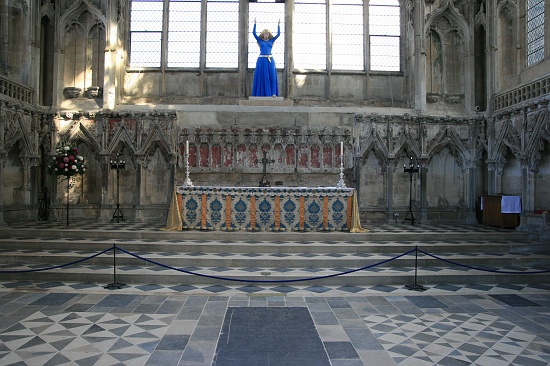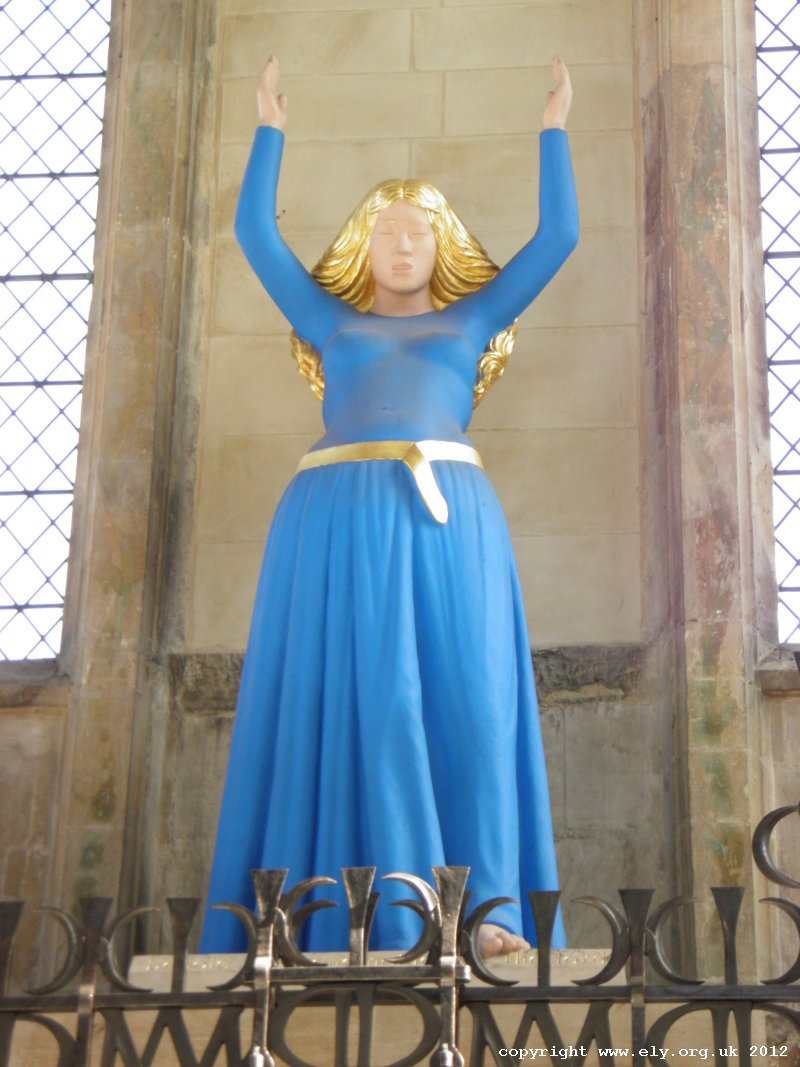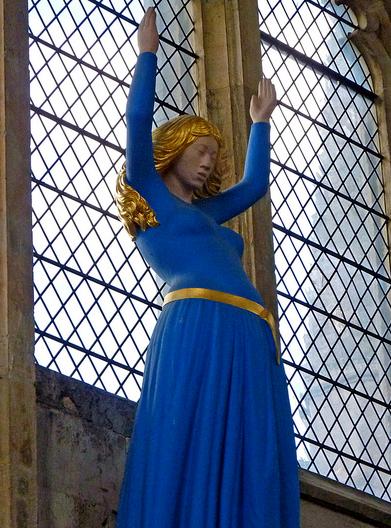Wynne’s Madonna at Ely: Love Goddess 2# November 26, 2012
Author: Beach Combing | in : Actualite , trackbackEly Cathedral is one of the great works of English civilisation. Approached by car or on foot over the flatlands of East Anglia it surges above the landscape. In fact, ‘the ship of the Fens’ is one of the few churches that can be enjoyed from a distance: so often we are reduced to glancing out the major works of Christian architecture down alleys and from corners in medieval cities with tight constricting street networks. Then there is the fourteenth-century Lady Chapel, the glory of glories… The Lady Chapel is one of the most seductive buildings in England. But it has also been, over the centuries, a source of instability. A collapse in the main cathedral in 1322 was likely caused by the building of said chapel. Fanatics targeted the cathedral because of the sculptures relating to Mary’s life therein in the Civil War. And in 2000 the Lady Chapel became the source of new controversy when a statue was unveiled above the main altar.
***Dedicated to Mrs B and a long ago summer***
At this point we need some disclaimers. Beach is not a Catholic, he is not a puritan, in fact, he is not a Christian. But he has, let’s say, Christian sensibilities and he feels he has to record David Wynne’s statue for those who might not get a chance for a visit between London, Cambridge and Stansted. The present writer considers this statue blasphemous, but it is blasphemous in such a curious way that it should be brought to the attention of all bizarrists. First, the statue in context and close up. Mary has an (empowered?) pose which is a long way from the mute, motherly figure we are familiar with and that many Catholics (men particularly) feel that they can melt into. She is placed, as noted and pictured supra, above the altar: the altar no less! (Beach was recently involved in a heated discussion with a colleague about the inappropriateness of putting modern sculptures on an antique altar, but this is a living church…) And she lifts her hands to the heavens as if gyrating in God’s spirit: hence the love goddess #2 to stand side by side with Beatrice. This is particularly evident when looked at from the side, her body is contorted out of sorts and appears to be close to some form of ecstasy or perhaps hip thrusts…
Her blue is, of course, the traditional colour of Mary, the blonde hair is perhaps well-suited to Germanic East Anglia. Seeing her in situ in one of England’s holiest spots is the closest that Beach has ever come to walking into a living Greek or Roman temple. In fact, while he was there a priest entered, knelt and prayed earnestly before her: the effect was shocking. A few centuries back the dreadful Cromwell barged into Ely Cathedral, arrested the bishop and closed the precincts because of ‘Catholic’ worship there. What would he have made of Blonde Disco-dancing Mary? For other controversial thoughts on the statue visit the relevant page of www.ely.org.uk Any other provocative sacred art from sacred buildings: drbeachcombing AT yahoo DOT com
***
26 Nov 2012: Invisible writes in with these considerations: I think the statue in the Ely Lady Chapel has much in common with the pregnant Virgin of Piero della Francesca and suspect that this image was at least partly the inspiration for the sculptor. The statue also has more than a suggestion of the character Merida in the animated film Brave, although obviously it predated the movie. I think I dislike the Ely Lady because I don’t find it particularly good art (and I speak as someone who has an irrational fondness for the doll-like, dressed images of the Iberian Peninsula.) Although it has been in place for 12 years, it seems, like guitar masses and calling God “she,” to be something ephemeral rather than eternal. The raised arms have no parallel in traditional Virgin iconography (with the possible dubious exception of some early Christian Virgins in the orans pose or of a few Crucifixion scenes) and I do not see how they represent any sort of empowerment. She looks more like someone performing a badly choreographed liturgical dance, another faddish form of worship which I hope has had its day, but which still sometimes rears its ugly legs under the guise of the scriptural authority that “David danced before the Lord.” What is left out is that David stripped to his underthings when he danced, but never mind… Modern feminism has imposed its own views of the Patriarchy on Medieval iconography. I cannot see how the Virgins of the Middle Ages were in any way images of subjugation. These images had real power: they could bless, they could curse, they could grant the prayers of their devotees. The sedes sapientiae/Throne of Wisdom images show the Virgin enthroned, crowned, bejeweled, often wearing the lorum of the Byzantine Empresses (some have said, even more blasphemously, that the accessory was a pallium, suggesting priestly powers for the Lady.) There are images of the Virgin in Italy said to be so powerful that they are capable of killing onlookers—so they are kept veiled. (See Madonnas That Maim: Popular Catholicism in Italy since the Fifteenth Century, Michael P. Carroll.) Medieval exempla are full of stories of people who disrespected a particular Virgin or her image and paid the price or, conversely, who revered the Virgin and were saved from some awful doom despite their sins. Even if I find the Black Virgin of Chartres or simpering Germanic virgins of the 15th century not to my aesthetic taste, there is no denying that these were powerful cult images, beloved and revered by those who prayed before them. Perhaps we are so hungry for ways to express our “spirituality” and sense of the Divine that this Lady of Ely will become a cherished cult figure. God forbid… It speaks too much of ill-judged attempts to rewrite hymnals, prayers, and scripture to make them gender neutral and to theological attempts to re-cast the Holy Spirit as a kind of fertility goddess.’ Thanks Invisible!
28 Nov 2012: Hilaire writes: ‘I was interested to see this statue of Mary at Ely – it is very unusual and striking! I just thought I must write and say how it appears to me. I think that it depicts Mary as a channel – her arms raised towards heaven, her eyes closed in concentration (not ecstasy) and her hips not gyrating but given prominence to emphasise the birth canal. That is the strongest impression to my mind. It shows Mary as the means by which God is made flesh and descends to the earthly plane; an intermediary. The divine born of woman. Her place above the altar therefore seems fitting. Her closed eyes and expression of concentration add to this sense of her giving herself up as a channel; it is quite self-effacing and not the expression of, say, a powerful goddess figure in her own right; it is still Mary in the service of God, or something greater than herself. This interpretation comes across particularly clearly in the picture taken from a distance.’ALshares these thoughts: ‘I recently attended a Nigerian Christian wedding. The statue’s posture is exactly the same as that of the dancing worshippers. I’ve come to the conclusion that, basically, a Nigerian church service is a party without any booze. I have also seen a very similar posture in Minoan statues of the “snake goddess”, the only difference being that she is holding snakes in her hands. There seems to be a sort of unconscious continuity of religious expression over a period of thousands of years. Incidentally, I went to boarding school in Ely. I bloody hated the place.’ It is a bit glum… The Count by the way writes that the poor old Ely Madonna looks like a sex toy! Thanks to Hilaire and AL!





